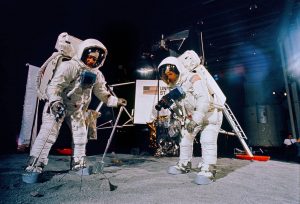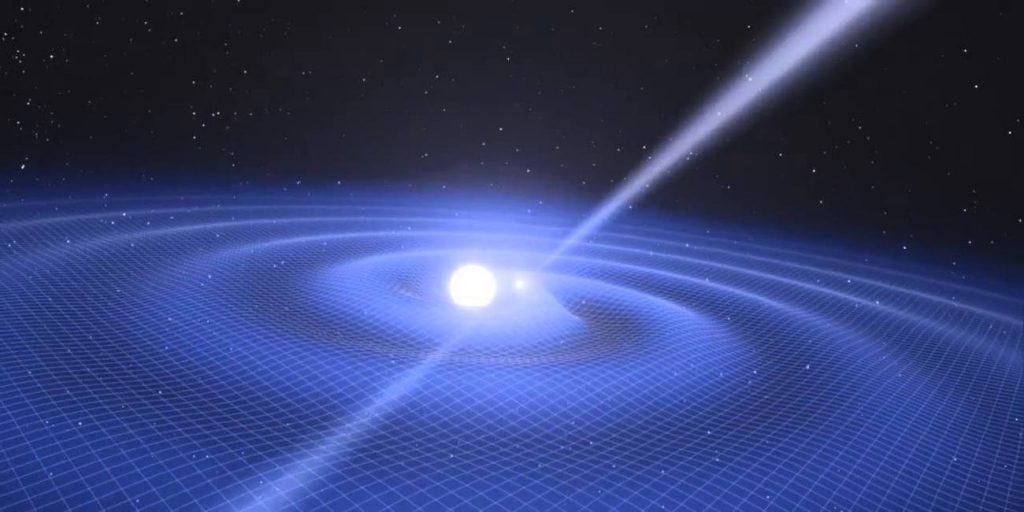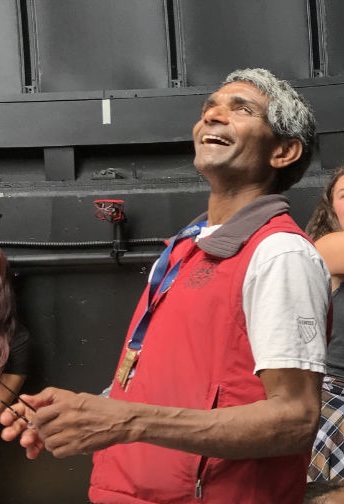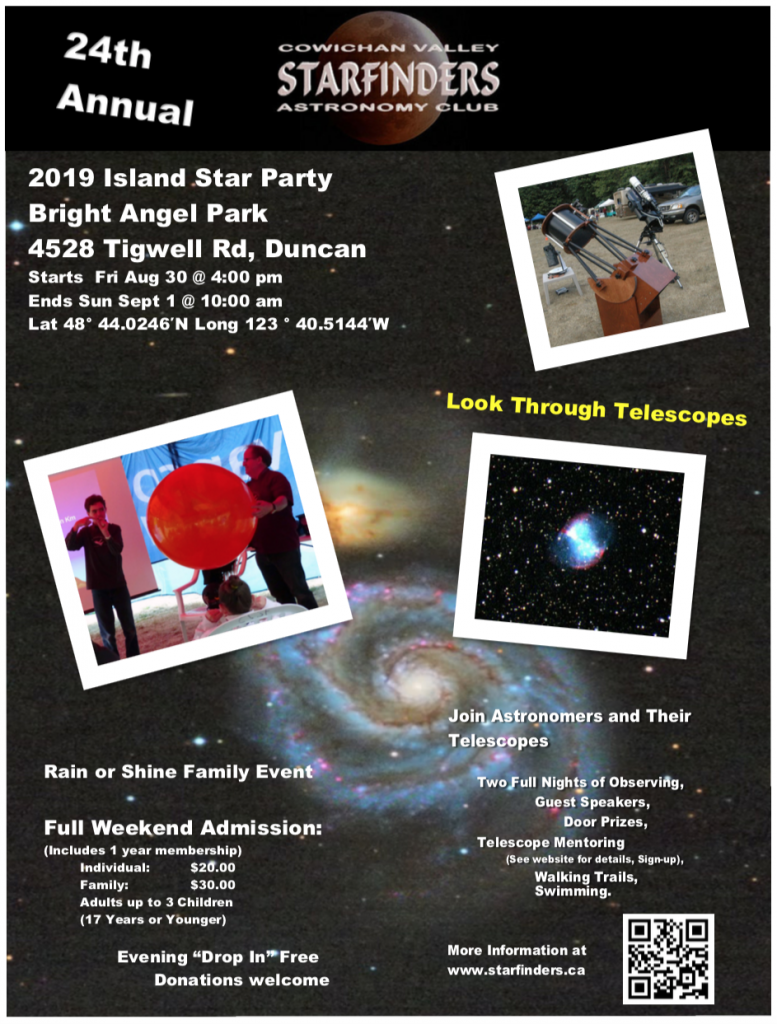July 20th marks the 50th Anniversary of the Apollo 11 Moon Landing. Due to media attention a desire to take a closer look at the Moon may grow as this date approaches. Unfortunately the Moon will not rise until 11:14PM on the anniversary of the landing. As a result the International Astronomical Union is organizing a global lunar observing event on July 12th called “On the Moon Again”. Between 8PM and 11PM on Friday July 12th, members of the Victoria Centre of RASC will set up telescopes in Oak Bay at the Cattle Point Dark Sky Urban Star Park. If weather permits they will be happy to share views of the Moon with you.

Victoria Centre telescopes will also be in position at the Dominion Astrophysical Observatory every Saturday evening in July from 7:15PM to 10:45PM for weekly Star Parties. These events, co-hosted with The Friends of the DAO, will include the following Moon related lectures:
July 6th: The Voyages of Apollo by Dr. Philip Stooke
July 13th: “Explore the Moon: My 50-Year, 30-Year, and 1-Year Projects” by Randy Enkin
July 20th: The Apollo Moon Walk by Dr. Chris Gainor
July 27th: Through the Knowledge Network: Space Suite Apollo and Space Suite IV
In addition to the above programs these Star Parties also include tours of the historic Plaskett Telescope, the Centre of the Universe Museum and Planetarium shows. Obtain free tickets to the Saturday Star Parties at the Dominion Astrophysical Observatory.
During the week of the July 20th the Friends of the DAO will hold the following additional lectures on Apollo at the Dominion Astrophysical Observatory, starting shortly after 7:00 PM.:
Tuesday July 16: Canada’s Contributions to Apollo by Dr. Chris Gainor
Wednesday July 17: Apollo in the Age of Aquarius by Dr. Dennis Crabtree
Thursday July 18: The Voyages of Apollo by Dr. Philip Stooke
The Centre of the Universe at the DAO will also be open to the public from 10 AM to 3 PM on Tuesday July 16 through Friday July 19.
Here is more detailed information of the scheduled Saturday Star Party lectures at the DAO:
July 6th 2019 – 8:30pm repeats at 9:30pm
The Voyages of Apollo
Dr. Philip Stooke
Abstract: A summary of the Apollo Program including its origins, steps along the way to the Moon, the choice of landing sites and a pictorial look at each mission.
Bio: Phil Stooke is a planetary scientist and cartographer with a PhD from UVic. He taught in the Centre for Planetary Science and Exploration at Western University in London, Ontario until his recent retirement. He has published The International Atlas of Lunar Exploration and similar books on Mars, and is currently revising his lunar atlas.
July 13th 2019 – 8:30pm repeats at 9:30pm
“Explore the Moon: My 50-Year, 30-Year, and 1-Year Projects”
Randy Enkin
Abstract: In 1969, at age 8, the Apollo missions motivated me to become an astronomer. Very quickly I mastered the subject, but then over the following 50 years I mostly found out how little I know. In this presentation, I will present my 30-year time series of lunar phase observations, and my lunar sketches from the past year which earned me the Royal Astronomical Society of Canada “Explore the Moon Observing Certificate” (https://www.rasc.ca/observing/explore-the-moon-observing-certificate). And you will be introduced to “Enkin’s Daily Moon” where images of the moon explore “the passage of time, illumination, the feminine, and world unity”. (https://www.facebook.com/EnkinsDailyMoon/)
Bio: Randy Enkin did not become a professional astronomer. He is a Research Scientist at the Geological Survey of Canada, working on earthquakes. He is an enthusiastic member of the Victoria Centre of the Royal Astronomical Society of Canada.
July 20th 2019 – 7:45pm to 10:45pm
The Apollo 11 Moonwalk with Dr. Chris Gainor
Abstract: This presentation will show the entire Apollo 11 moonwalk as it was televised on the evening of July 20, 1969, along with descriptive slides. Chris Gainor will discuss the flight of Apollo 11, the symbolic aspects of the first walk on another celestial body, and the scientific work carried out by astronauts Neil Armstrong and Buzz Aldrin on the lunar surface. The presentation will begin shortly before 8 p.m., just as it did in real time in 1969, and will continue for the two hours and 40 minutes of this historic event.
Bio: Chris Gainor is a historian specializing in the history of space flight and aeronautics. He has five published books and is currently writing a history of the Hubble Space Telescope for NASA. He is President of the Royal Astronomical Society of Canada.
July 27th 2019 – 8:30pm to 10:45pm
Through the Knowledge Network: Space Suite IV and Space Suite Apollo
Producers – Imagine Create Media
Space Suite IV
A series of 10 short films that explore the infinite wonders of our universe and our interactions with the cosmos.
Space Suite Apollo
Trace the history of NASA’s Lunar missions from Mercury to Gemini, to the Apollo Missions that ultimately landed a man on the moon. Set to the music of Johann Sebastian Bach, Space Suite Apollo gives viewers an unflinching look at the raw footage that continues to capture the world’s imagination.
Matthew Williams
7:30PM Wednesday, June 12th 2019
Room A104 Bob Wright Centre, UVic

The dream of traveling to the nearest stars is one that has haunted the public imagination for centuries. But it has only been in the past few decades that we have been able to contemplate what such a journey would look like. And in recent years, the desire to send missions to neighboring planets – and also neighboring stars – has reemerged with a vengeance. There are many reasons for this: the Voyager 1 and 2 probes recently joined each other in interstellar space, the discovery of exoplanets (including one next door) has inspired scientists to look for life on them directly, and emerging technology has been making space travel cheaper and more accessible. But how (and when) will we “go interstellar”? As with most things having to do with space exploration, the simplest answers are: “How fast do we need to get there?” and “How much are we willing to spend?”
Matthew S Williams is a professional writer for Universe Today and Interesting Engineering. His articles have been featured in Phys.org, HeroX, Popular Mechanics, Business Insider, Gizmodo and IO9, Science Alert, Knowridge Science Report, and Real Clear Science, with topics ranging from astronomy and Earth sciences to technological advances, environmental issues, and the search for extra-terrestrial intelligence (SETI). He is a former teacher, a science-fiction author, and a 5th degree Black Belt Tae Kwon-Do instructor. He lives on Vancouver Island with his wife and family.
7:30 PM Wednesday May 8th 2019 in Room A104, Bob Wright Centre at the UVic
Instead of featuring a single speaker the May meeting will be a “Members Night” where a number of Victoria Centre RASCals will deliver short presentations on their projects, imagery or fascinating topics. It should be a fun night. We hope to see you there.
- Royal BC Museum Classroom Kit – DAO Outreach demonstration – Lauri Roche
- Jupiter and the Juno Mission – Reg Dunkley

Dr. Karun Thanjuvar
7:30 PM, Wednesday, April 10th; 2019 in Room A104, Bob Wright Centre, UVic
Artificial intelligence (AI), especially Deep (Machine) Learning applications, are already ubiquitous and in everyday use, and have been called the second industrial revolution. Deep Learning algorithms, called Neural Networks, thrive on Big Data. The happy ‘problem’ we now face of enormous amounts of data available in this digital era. In astronomy too,telescopes will soon routinely produce terabytes of data every night. Piggybacked on the impressive recent advances in high performance computing, neural networks are trained on these available large datasets to then perform a variety of human-like tasks, such as real-time decision making, identifying subtle patterns in the data, forecasting and making recommendations based on experience, and so on. In this presentation I aim to provide an overview of this rapidly burgeoning field, explain in simple terms the construction and working of a neural net, and illustrate these principles with a working model.
Dr. Karun Thanjuvar: As an observational cosmologist, discovering new gravitational lenses and developing innovative techniques to harness them as observational tools are amongst my diverse research interests. As part of my doctoral thesis at UVic in 2009, I developed an automated technique to search for lenses in wide field, pan-chromatic imaging. These explorations of the distant universe come after a full career as a mechanical engineer, specializing in control systems and robotics. Born andraised in a small town in South India, I completed my education up to a bachelor’s degree in mechanical engineering there, before moving to Canada to pursue graduate studies; first in Robotics, and later in Astrophysics. After my PhD from UVic, I worked as a Resident Astronomer at CFHT in Hawaii for three years, before returning to UVic to accept a position as a senior lab instructor in astronomy. Even though undergraduate teaching is the focus of my current position, I continue to pursue various research projects. I also enjoy sharing the excitement of science and my research efforts with the public through several outreach initiatives through the UVic observatory.
Normally at the beginning of March Victoria Centre RASCals are trudging through cherry blossoms. Snow is not an option. So just imagine your puzzled president when he arrived at the VCO on February 27th. The observing pad was covered with 6 inches of white stuff topped with an icy crust. This unseasonably cold weather tormented tender West Coast RASCals throughout February and almost derailed the Mini AGM of February 13th.
Mini AGM you say? This administrative AGM resulted from trying to make others happy. To streamline financial procedures the Canadian Revenue Agency wanted the Victoria Centre to move our fiscal year end from September 30th to December 31st. When we did that the BC Societies Act insisted that we hold an AGM in 2019. So this “administrative AGM” which covers the three month interval extending from October to December 2018 was scheduled to coincide with the February monthly meeting. This would make the CRA happy and the BC Societies people happy … but there was a problem.
It all has to do with our bylaws. When the bylaws were recently updated the quorum was boosted from 3 to 25. The architects of these new bylaws never envisioned that the “Garden City” would be paralyzed by snow. Since North Saanich was buried under 2 feet and many members were trapped in unplowed cul de sacs it was looking like the Mini AGM was toast. Fortunately these very same bylaw architects included a provision for proxy votes. At the last minute your desperate president e-mailed the membership with a plea for proxies. The first proxy arrived from Tasmania! Nearby RASCals also rallied to the cause. A quorum was established and the first Mini AGM in the 104 year history of the Victoria Centre went ahead. Let us hope that it will also be the last Mini AGM in history as this bureaucratic process is more complicated than astrophysics.
Speaking of “astro” things let’s talk about AstroFest 2019. This event, the first of its kind, was held in Nanaimo on February 28th. It was extremely well organized and hosted by the Nanaimo Astronomy Society. The idea was to bring Island astronomers together to share their knowledge and enthusiasm. This mid island rendezvous was well advertised and over 120 attended the event. Nelson Walker, Bill Weir and I manned the Victoria Centre table while Lauri Roche and Ben Dorman represented the FDAO. Victoria Centre RASCal Francois Pilote led a contingent of 5 from the Comox Valley and Victoria member Mike Krempotic came from Port Alberni. Dennis Crabtree set up the very popular virtual reality system and captivated many.
There were a number of presentations. I provided info on the Victoria Centre while Nanaimo President Chris Boar described the activities of the Nanaimo Society. In addition to talks at their monthly meeting they hold many outreach events and like Victoria are swamped by the curious public during eclipses. They also take time to have fun and schedule an annual Beer and Burger night. The Cowichan Valley Starfinders promoted their star party and Nigel Mayes from Shawnigan Lake School described their facility and active astronomy program. John and Carol Nemy delivered a spectacular visual presentation of the night sky which featured their Island Stars Observatory located on Hornby Island. The members of the Nanaimo Astronomy Society were very friendly and hospitable. Several members had roll off roof observatories. Many of the attendees were newbies looking for ways to get involved in Astronomy. Bruce Lane from Quarky Science donated a nice pair of binoculars as a door prize. There was great enthusiasm for this event and it is hoped that it will be repeated. Special thanks must go to Chris Boar, Tony Puerez and Janeane MacGillivary for magically making it all happen.
Snowless Days
Cloudless Nights
Reg Dunkley
Dr. J.J. Kavelaars
7:30 PM Wednesday March 13th
Room A104, Bob Wright Centre at UVic
On January 1st, 2019 NASA’s New Horizons spacecraft executed a flawless encounter of the small world provisionally known as 2014 MU69. Our understanding of the nature of the outer solar system and processes of planet formation have been transformed by the very first resolved images of 2014 MU69. Now, 2 months after encounter, the imaging and spectroscopy from 2014 MU69 continue to trickle in. I will describe the processes that enable this historic encounter to occur and the initial results from the spacecraft imaging.
Dr. JJ Kavelaars received his Ph.D. from the Department of Physics at Queen’s University in Kingston ON in 1998. He is an Astronomer at the Dominion Astrophysical Observatory in Victoria and is a member of the Canadian Astronomy Data Centre. His areas of interest include the outer solar system including the Kuiper belt. This specialty enabled him to assist in selecting a followup target for the New Horizons spacecraft after it flew by Pluto. While studying irregular planetary satellites JJ and his team discovered 23 moons surrounding Saturn, Uranus and Neptune. In 2016 he discovered the sixth dwarf planet in the solar system.
